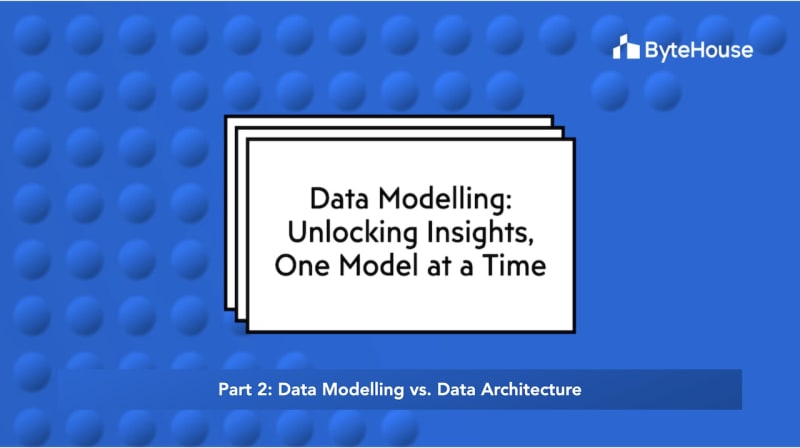Part 2 out of 5 of 'Data Modelling: Unlocking Insights, One Model at a Time' series
This blog post is Part 2 of ByteHouse's 5-part series titled Data Modelling: Unlocking Insights, One Model at a Time.
This series will cover the following topics:
- Basics of data modelling and data models
- Data modelling vs. data architecture
- The data modelling process
- Data modelling techniques
- Benefits of data modelling
Data plays a pivotal role in today's world, serving as the cornerstone for businesses to make informed decisions. In the realm of managing data, terms like "data modelling" and "data architecture" are often used, sometimes interchangeably, leading to confusion among many. In this post, we'll delve into the intricate details of both concepts, unravelling their unique roles and highlighting the distinctions that set them apart.
Data modelling: The blueprint
At its core, data modelling is akin to crafting a detailed blueprint before constructing a building. It's a meticulous process where data scientists and engineers define the structure, relationships, and constraints of data to create a logical representation. Data modelling focuses on understanding business requirements and transforming them into a conceptual framework. It answers questions like, "What data do we need?" and "How are different data elements related?"
Data modelling employs techniques like Entity-Relationship Diagrams (ERDs) and UML diagrams to visualise data entities and their associations. It provides a clear roadmap for database developers and architects to create efficient databases. In essence, data modelling is the art of organising data, ensuring it aligns seamlessly with business objectives.
Data models are used by a variety of stakeholders, including:
- Data modellers: Data modellers are responsible for creating and maintaining data models.
- Database designers: Database designers use data models to design the physical structure of databases.
- Developers: Developers use data models to write code that interacts with databases.
- Business analysts: Business analysts use data models to understand and analyse data.
Data architecture: Building the ecosystem
While data modelling lays down the theoretical foundation, data architecture is the practical implementation of the concepts within an organisation's data ecosystem. Data architecture encompasses various components, such as databases, data warehouses, data lakes, and data pipelines. It defines the standards, policies, and technologies needed to manage, store, and transport data securely and efficiently.
By outlining the standards, policies, and protocols governing data storage, access, and integration, data architecture ensures that the data infrastructure is scalable, reliable, and able to handle the ever-increasing volumes of data generated daily. It also addresses factors like data security, data integration, and data governance. Unlike data modelling, which is conceptual, data architecture deals with the tangible, technical aspects of data management.
Data architects work with a variety of stakeholders, including:
- Business leaders: Data architects work with business leaders to understand their data needs and develop a data architecture that meets those needs.
- IT professionals: Data architects work with IT professionals to implement and manage the data architecture.
- Data scientists: Data architects work with data scientists to develop and deploy data science applications.
Key differences: Where data modelling and data architecture diverge
Scope and abstraction:
- Data modelling: Focuses on the conceptual and logical representation of data, abstracting it from technical details.
- Data architecture: Deals with the physical implementation and technical aspects, translating abstract models into real-world systems.
Timeframe and granularity:
- Data modelling: Typically done in the early stages of a project, providing a high-level view of the data requirements.
- Data architecture: Involves ongoing activities, ensuring that data systems evolve and adapt to changing business needs, often at a more granular level.
Focus areas:
- Data modelling: Concentrates on data entities, relationships, and business rules, emphasising the 'what' and 'why' of data.
- Data architecture: Concerned with data storage, processing, integration, and security, addressing the 'how' and 'where' of data management.
Understanding these differences is crucial for organisations aiming to harness the full potential of their data.
Data modelling and data architecture are two essential, symbiotic components in the data lifecycle. Data modelling sets the direction, guiding how data should be organised and structured, while data architecture brings these models to fruition, ensuring that data is stored, processed, and utilised efficiently.
Understanding these distinctions empowers businesses to establish robust data strategies, enabling them to navigate the complexities of the digital landscape effectively.




Top comments (0)